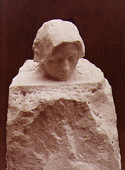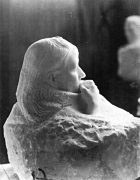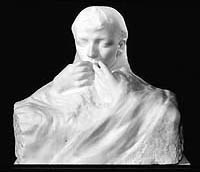Rodin Works: the thought, Farewell |
|
Whereas the 'The Thinker' is characterized by a strained posture, 'The Thought' rather shows a mental process that has been detached from the coercive forces of the material world. The head is isolated from the rest of the body, as if to represent the topos of free-floating thought. The Breton bonnet, symbolizes a kind of thinking cap, shields the head from outside disturbance. An early terracotta version is exhibited in Leipzig. The marble version was executed in 1893/95. Rodin entrusted his practician Victor Peter with the carving - like he mostly assigned his assisstants with the translation of his works into marble. Later, Peter told the story that Rodin, supervising his progress, at a certain moment stopped any further editing by saying: "Don't do anything more, leave it like that!" And so the delicately sculptured head of the bust remained, from the chin downwards, joined to an untreated, raw and massive block. The same proceeding was chosen for the 'Bust of the Duchesse de Choiseul': Rodin stopped the working on this bust before the hair was finished so that a helmet-like formation emerges from the rough-hewn block. Critical voices claimed Rodin's decision
to let Camille's head directly evolve from the pedestal might have served
to conceal her somewhat floating chin line. By that year, the passionate relationship between
Rodin and Camille had passed its highest point already.
|
 The
portrait of Camille Claudel 'The Thought' was probably created in 1886, three
years after the first meeting of the sculpor with his talented model and
pupil, who soon was to become his lover. The work is an adaption of a
portrait of Camille with a Breton cap.
The
portrait of Camille Claudel 'The Thought' was probably created in 1886, three
years after the first meeting of the sculpor with his talented model and
pupil, who soon was to become his lover. The work is an adaption of a
portrait of Camille with a Breton cap.

 Rodin had
refused to abandon his old companion Rose Beuret, Camille was not willing
to accept the role of a mistress. In 1892, she spent the summer months at
the Chateau d'Islette without Rodin and started drawing acid caricatures about the elder sculptor, "glued" to his jealous
Rose
: the complicated triangle relationship, that for a certain
period of time had been an exciting secret, had started to disintegrate.
'Farewell' combines the head of Camille with two separate hands, that can
be associated with idleness, lack of productivity, or the gesture of
saying goodbye.
Rodin had
refused to abandon his old companion Rose Beuret, Camille was not willing
to accept the role of a mistress. In 1892, she spent the summer months at
the Chateau d'Islette without Rodin and started drawing acid caricatures about the elder sculptor, "glued" to his jealous
Rose
: the complicated triangle relationship, that for a certain
period of time had been an exciting secret, had started to disintegrate.
'Farewell' combines the head of Camille with two separate hands, that can
be associated with idleness, lack of productivity, or the gesture of
saying goodbye.